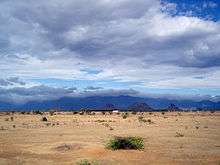Climate of Tamil Nadu


The Climate of Tamil Nadu, India is generally tropical and features fairly hot temperatures over the year except during the monsoon seasons.
History
Under the Köppen climate classification the greater part of Tamil Nadu falls under Tropical savanna climate and a smaller portions of the state falls under Humid subtropical climate; the climate of the state ranges from dry sub-humid to semi-arid.
Seasons
Summer
The summer in Tamil Nadu runs throughout March,April and May and is characterized by intense heat and scant rainfall across the state.
Winter
The cold weather commences early in December and comes to an end in the middle of March. The climate in the cold weather is pleasant. The days are bright and sunny the sun is not too hot.
As soon as the sun sets the temperature falls and the heat of the day yields place to cooler weather.
Monsoon
The state has three distinct periods of rainfall: advance rainfall ; rainfall from the tropical cyclones emerging in the neighbourhood of the Andaman islands during the Retreat of Monsoons(October–November); and the North East monsoon during the months of October–December, with dominant northeast monsoon winds from the western disturbances emerging over the Mediterranean Sea. The dry season is from February to early June.
Tamil Nadu has rain during the monsoon season due to the southwest trade winds which blow towards the northern hemisphere. Tamil Nadu receives rainfall in the winter season due to northeast trade winds. The normal annual rainfall of the state is about 945 mm (37.2 in) of which 48% is through the North East monsoon,and 32% through the South West monsoon. Since the state is entirely dependent on rains for recharging its water resources, monsoon failures lead to acute water scarcity and severe drought.
Tamil Nadu is classified into seven aggro-climatic zones: north-east, north-west, west, southern, high rainfall, high altitude hilly,and Cauvery Delta (the most fertile agricultural zone).
Statistics
Temperature
| — | Winter (Jan – Feb) |
Summer (Mar – May) |
Monsoon (Jun – Sep) |
Post-monsoon (Oct – Dec) |
Year-round | ||||||||
|---|---|---|---|---|---|---|---|---|---|---|---|---|---|
| City | Jan | Feb | Mar | Apr | May | Jun | Jul | Aug | Sep | Oct | Nov | Dec | Avg |
| Chennai | |||||||||||||
| Coimbatore | 32 | - | - | - | - | - | - | - | - | - | - | - | - |
| Madurai | |||||||||||||
Precipitation
| — | Winter (Jan – Feb) |
Summer (Mar – May) |
Monsoon 1 (Jun – Sep) |
Monsoon 2 (Oct – Dec) |
Year-round | ||||||||
|---|---|---|---|---|---|---|---|---|---|---|---|---|---|
| City | Jan | Feb | Mar | Apr | May | Jun | Jul | Aug | Sep | Oct | Nov | Dec | Total |
| Chennai | |||||||||||||
| Coimbatore | |||||||||||||
| Madurai | |||||||||||||
Disasters
Floods
2015 South Indian floods ( mostly affected areas chennai and cuddalore) Chennai received 1,049 mm (41.3 in) of rainfall in November, the highest recorded since November 1918 when 1,088 mm (42.8 in) in of rainfall was recorded.[24][25] The flooding in Chennai city was described as the worst in a century.[26]
Cyclones
2004 Asian tsunami disaster
Drought & famine
Pollution
. 0%
See also
References
- 1 2 "Weatherbase". Weatherbase. Retrieved 2007-03--. Check date values in:
|accessdate=(help) - 1 2 "Wunderground". Weather Underground. Retrieved 2007-03--. Check date values in:
|accessdate=(help) - 1 2 "Weather.com". The Weather Channel. Retrieved 2007-03--. Check date values in:
|accessdate=(help)